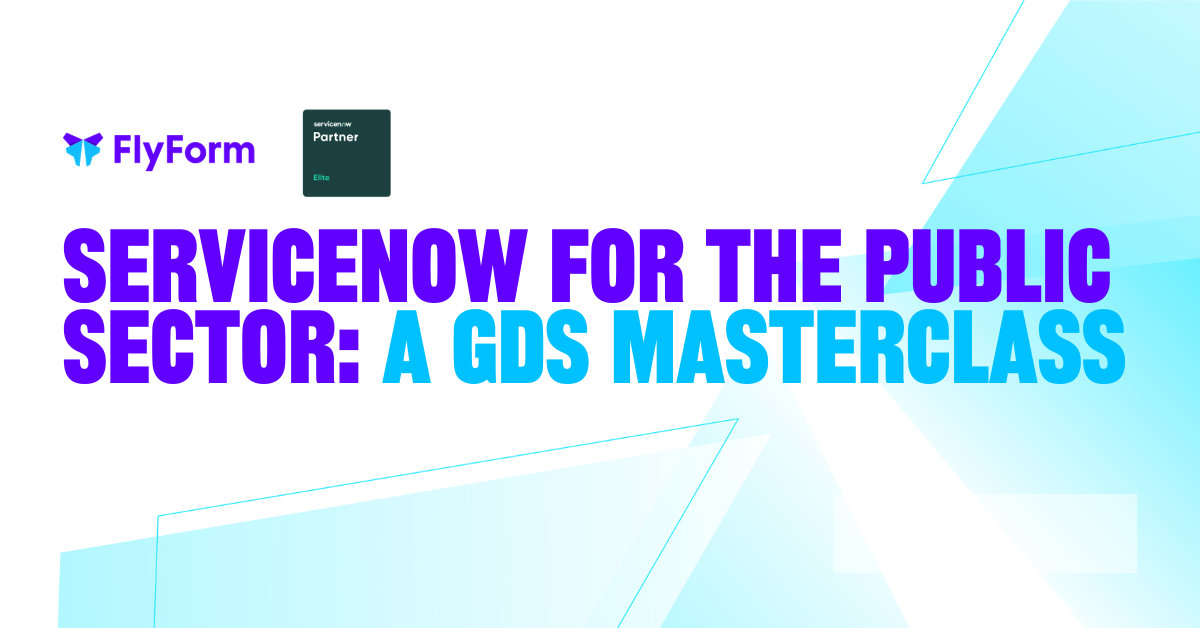Digital transformation is an ongoing journey – but where should you begin? Here are the 6 key steps you should take to ensure a successful transformation in the public sector with ServiceNow.
In an age of increasingly interconnected, data-driven digital experiences, the public sector finds itself with a pressing need for transformation.
Today’s citizens demand greater efficiency, transparency and accessibility from their governments, leaving departments and agencies under fire from all sides to deliver services better, faster and to more people – all for less time, money and resources.
There’s a mountain of obstacles to overcome on this journey to digital service perfection – and platforms such as ServiceNow are ideally placed to help get you there – but where you start or what you prioritise isn’t always so clear.
In this blog, we’ll walk you through the key steps to take with expert advice on how ServiceNow can support each stage to transform the way you deliver IT services.
Why is digital transformation needed in the public sector?
The public sector is quite a contradiction when it comes to digital transformation.
On the one hand, it’s well-placed to demonstrate the benefits of better services at a cheaper cost. On the other, it’s historically slow to move – leaving many transformation initiatives to die on the rocks of legacy technology, complex silos and organisational red tape.
But there are several compelling reasons to pursue transformation in the public sector:
- Enhanced efficiency and cost savings: Many public sector agencies are burdened by outdated manual processes, leading to inefficiencies and increased operational costs. Modernisation can streamline operations, automate tasks and save taxpayer money.
- Improved service delivery: Citizens expect government services to be accessible, user-friendly and efficient – similar to their experiences in the private sector. Modernisation can lead to improved service delivery and greater citizen satisfaction.
- Data security and compliance: As the volume of sensitive data collected by the public sector increases, there's a growing need for robust data security and compliance measures. Modernisation can bolster security and ensure adherence to data protection regulations.
- Remote work capabilities: The COVID-19 pandemic changed the way we work and highlighted the importance of remote work capabilities. Modernising public sector operations enables employees to work remotely when necessary, ensuring business continuity.
- Data-driven decision-making: Modernisation allows for better data collection and analysis, which can inform the decision-making process. This can lead to more informed policy decisions and resource allocation.
- Citizen engagement: Modernisation can enable better citizen engagement through digital platforms, making it easier for citizens to access information and interact with government agencies.
What we see currently in the public sector is outdated technology, silos and fragmentation, a low level of automation, inadequate data management and a limited citizen-centric approach. The result? Slow and costly service delivery – and poor experiences for citizens and staff alike.
The public sector needs to transform to improve efficiency, citizen satisfaction, data security and decision-making.
ServiceNow is well-positioned to facilitate this transformation by providing an integrated platform, automation, data management and user-centric solutions that address the current shortcomings in public sector operations.

Webinar: ServiceNow for the public sector – a GDS masterclass
It can be frustrating when public sector services fail to live up to expectations.
Fortunately, ServiceNow's GDS Toolkit is here to help.
Watch this webinar on-demand now to discover:
- The key challenges we see in our public sector clients
- The role of the GDS Toolkit in your digital transformation
- How to quickly create GDS-aligned services built on ServiceNow
The Public Sector Digital Transformation Checklist
Let’s dive into the six key stages that should shape your approach to digital transformation:
1. Make proper use of your data
Data-driven decision-making is fundamental for public sector organisations because it enables you to make informed choices based on empirical evidence rather than intuition or anecdotal information.
Data allows you to gain a deep understanding of the needs, preferences and behaviours of your users. When used and managed correctly, data can help you identify patterns, trends, and workflow bottlenecks – then make smart decisions for achieving service optimisation and cost efficiency.
The Now Platform empowers you to establish good data governance policies, ensuring data quality, security and compliance – which is crucial when handling sensitive citizen information and maintaining trust.
But it also offers you the tools to drive effective transformation, whether that’s using performance analytics for service reporting and trend analysis, integration capabilities to streamline data flow, or automation engine to deliver workflow automation.
However, it’s important to remember that technology impact is often limited by data quality – ‘garbage in, garbage out’, as they say.
Many organisations have fallen foul of assuming the technology will magically generate meaningful insights without first ensuring the starting point for data is as clean as possible.
The most successful transformations recognise that data review and cleansing can require a lot of time (depending on data size and number of sources) – so starting this activity as early as possible is crucial to optimising your ROI.
2. Digitise your services
At a time when economic agility and ‘bang for your buck’ are more scrutinised than ever before, public sector organisations must streamline their operations and service delivery to ensure efficiencies and productivity are maximised.
Therefore, digitising the clunky paper-based processes of the past should be prioritised early because it’s a key step in bringing about significant improvements in service delivery and efficiency.
Incorporating services into ServiceNow accelerates this process and enables you to leverage key platform capabilities such as GenAI, machine learning (ML) and natural language understanding (NLU) to deliver greater user-centric services, accessibility and transparency.
Adding or replicating citizen-facing services in ServiceNow is now easier than ever thanks to our GDS Toolkit which vastly reduces the time required to digitise your old services via a modular interface and GDS-aligned portal experience. You can find out more about the Toolkit on our product page.
Very often, we see public sector organisations creaking under the weight of lots of on-premises technologies, overlaps in capability, and uncertainty of truth in their data.
Convoluted architectures, services and applications create cost inefficiencies, add maintenance overheads and increase risk posture.
Once your services are digitised via the Now Platform, we’d recommend using Application Portfolio Management in ServiceNow to reduce any excess applications or services to clean up your portfolio and reduce its maintenance.
It’s proven to help some clients reduce the number of on-premises applications by up to 20%, as well as reduce maintenance time by approximately 48% – so well worth doing.
3. Consolidate your services and operations
Streamlining and consolidating your services is a key step to eliminating redundancies, reducing administrative overhead and optimising resource allocation.
While digitisation is crucial for modernising public services, it typically focuses on transitioning manual or paper-based processes into digital formats.
After taking these initial steps towards digital transformation, you’ll better understand your processes and the data generated, which can inform subsequent streamlining efforts.
However, streamlining is not a ‘one-and-done’ process and can run concurrently alongside other stages in some cases, especially if clear redundancies are identified early in the digitisation journey.
Consolidating processes and simplifying (as much as realistically possible) maximises your automation adoption opportunities and ties into many of the capabilities within ServiceNow’s platform.
For example, the Service Catalogue and Request Management capabilities streamline your service requests, Service Level Management ensures adherence to performance standards, the Service Operations Workspace offers real-time visibility and collaboration, and a common service data model enhances data consistency and interoperability.
When combined, these all work together seamlessly for more efficient and responsive public services.
Want to use ServiceNow AND meet your GDS requirements? Find out how in our eBook.
Download my free eBook4. Put citizens at the centre
Putting citizens at the centre of your service design and delivery needs to be a priority because it helps focus your efforts to create more effective and citizen-centric government services.
When citizens are at the forefront of service planning and execution, it results in several key benefits:
- Improved user satisfaction: By tailoring services to citizens' needs and preferences, you’ll enhance their satisfaction. When services align with what citizens actually want, their experience improves, leading to greater trust in government.
- Enhanced efficiency: Designing services with citizens in mind helps eliminate unnecessary steps and processes. This optimisation streamlines service delivery, making it more efficient for both the government and citizens.
- Better resource allocation: Focusing on citizen needs enables you to allocate resources more effectively. By concentrating on areas with the greatest demand or impact, you’ll make the best use of your budgets and personnel.
- Data-driven improvements: To understand and meet citizen needs, governments rely on data and feedback. This data helps identify pain points, preferences and trends – ensuring that services evolve and improve over time.
- Increased transparency and accountability: Engaging citizens in service design fosters transparency. When the public is involved in decisions about services, they have a better understanding of government processes and greater trust in government operations.
ServiceNow’s UX and UI are driven by citizen preferences, offering tailored experiences for citizens depending on their choices. This experience is then consistent across every channel and interaction, and the recent introduction of generative AI helps enhance the support experience and personalisation.
With ServiceNow, you’ll be able to engage citizens, gather valuable service data and feedback, and use that information to design and deliver services that better meet the needs of your constituents.
This not only improves citizen satisfaction but also enhances government efficiency and accountability.
5. Invest in increasing public trust
Building and maintaining public trust is critical for any government organisation because trust is the foundation of effective governance and citizen engagement.
When citizens receive timely and effective services, they’re more likely to have faith in the government's ability to meet their needs.
So, when it comes to improving the service experience to create that trust, clear and open communication is crucial. You’ll need to provide accurate information, respond quickly to their inquiries and concerns, and engage in two-way dialogues to ensure citizens feel heard and respected.
On top of this, a focus on data privacy is also essential to earn citizens’ trust. Users must feel safe in the knowledge that their personal information is handled securely and in compliance with relevant laws and regulations.
ServiceNow’s secure-by-design architecture, privacy controls, data separation, and communication capabilities delivered across portals, mobile apps, live chat, SMS, and virtual agents will help you build and maintain public trust by promoting transparency, data privacy, effective communication and accountability.
The good news is you can now deliver all of these features in your citizen-facing services whilst also supporting the GDS accessibility standards with our new Toolkit – further enhancing trust by ensuring your services are recognisable and accessible to all.
A top tip from us; when evaluating your service channels and citizen experience for improvements, it's important to focus on the primary two or three channels initially, with expansion to other methods if the data justifies this.
You need to know how most of your users are interacting with your services and seek to understand if this is either by preference or because it’s the best of the available options.
We find the most successful approach is to use ServiceNow’s Virtual Agent (aka chatbot) for simple yet high-volume interactions, such as password resets and checking for updates. This will help you improve citizen engagement, satisfaction and trust by providing a round-the-clock, efficient way to solve everyday enquiries.
6. Improve innovation and agility
Encouraging innovation and agility throughout the improvement process is crucial to adapt to evolving citizen needs, emerging technologies and changing circumstances.
Here's why innovation and agility are important:
- Adaptability: Government organisations must be able to respond swiftly to new challenges, opportunities and policy changes. Encouraging agility enables you to adapt your services and operations accordingly.
- Continuous improvement: Innovation and agility foster a culture of continuous improvement, where organisations are constantly seeking better ways to deliver services, streamline processes, and meet citizen expectations.
- Citizen-centricity: Embracing innovation allows you to design services with citizens in mind. It enables the development of creative solutions that address specific citizen needs effectively.
- Resource optimisation: Being agile means efficiently allocating resources to high-impact areas. It ensures that limited resources are used effectively and efficiently.
ServiceNow’s workflow automation, process optimisation, innovation management, strategic planning and delivery, continual improvement management, DevOps, and low code development are a few examples of how it’s supporting public sector organisations to encourage a culture of innovation and agility.
This is a lot of capability, and it’s important to approach these in a logical sequence to support adoption and organisational change. For example, you wouldn’t automate any workflows until processes have been optimised or try to establish continual improvement without first understanding your strategy and objectives to see where you can align initiatives.
With the right digital strategy and technologies in place, you can better respond to changing conditions, citizen needs and technological advancements with speed and flexibility – achieving that end goal of more effective and citizen-centric services.
The GDS Toolkit
We’ve mentioned it a few times throughout this blog, but a key piece to solving the digital transformation puzzle in the public sector is our GDS Toolkit for ServiceNow.
More and more government departments and agencies are benefiting from the Now Platform’s powerful automation, data governance and AI capabilities – our own work with the DVSA has seen a 74% increase in user satisfaction since they adopted the platform.
But it hasn’t been a complete transformation until now because there wasn’t a way to use ServiceNow for public-facing services in a way that also met the GDS standard. And that’s exactly what our Toolkit is designed to fix – to enable you to create or recreate ServiceNow-powered services for citizens via a fully GDS-aligned portal experience.
The Toolkit seamlessly adapts the Now Platform for use in citizen services, using a modular design to replicate approved design styles and enable support for key accessibility features such as screen readers, keyboard controls and more.
You can find out more about the Toolkit’s capabilities in the video below (or you can explore our dedicated product page for full details):
Interested in learning more about the GDS Toolkit?
Visit the GDS Toolkit pageAchieve your transformation – the right way
There are many pitfalls on the path to digital transformation – especially in the public sector. The steps and advice we’ve outlined in this blog will help point you in the right direction, but there’s no substitute for experience when it comes to implementing them.
Which is where we come in. Our extensive heritage in the public sector means that we understand the true extent of your challenges. There isn’t much we haven’t seen before from our work with the DVSA, FCDO and Home Office, to name a few.
As such, we’re ideally placed to help you get to the root of what you’re trying to achieve and quickly cut out the legacy tech and unnecessary expenditure to deliver that efficient, modern IT service experience your staff, citizens and senior stakeholders expect.
Key takeaways
- The public sector faces a pressing need to modernise how it delivers services with increasingly restricted resources and budgets.
- How you begin your transformation will determine much of its success, so follow the six stages outlined in this blog to build a strong foundation.
- ServiceNow offers an opportunity to streamline your IT with enhanced data governance, efficient automation and interconnected workflows.
- ServiceNow’s innovative and adaptable UI and UX help improve service delivery across every channel, making use of intelligent chatbots and machine learning.
- ServiceNow is helping many public sector organisations transform their internal IT services – now, thanks to our GDS Toolkit, those benefits and capabilities can be used for public-facing services as well.


